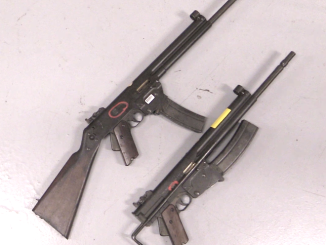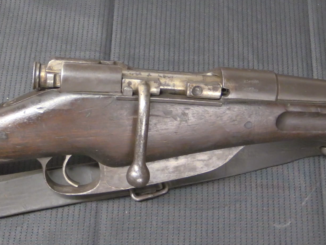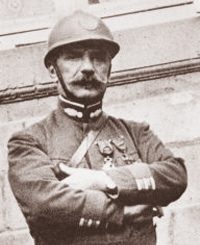At the end of World War Two, the Mauser factory complex was in the French occupation zone, and more than a few Mauser engineers went to work for the French. Among them were Ludwig Vorgimmler and Theodor Löffler. These two men joined the Centre d’Etudes et d’Armement de Mulhouse (CEAM) and worked on the French program to develop new small arms. Specifically, they were involved in programs to create both a semiauto carbine to fill the role of the US M1 Carbine and also a rifle to take the role of the German Sturmgewehr.
What we are looking at today is the last in the line of CEAM’s carbines. These began using a proprietary 7.65x35mm cartridge, but this was changed to .30 Carbine in the late 1940s. This uses the roller-delayed mechanism first developed at Mauser during the war, and incorporates many features of the MP44. It also has an integral bipod/handguard and a side-folding stock. The H&K type bolt head locking lever had not yet been developed, and this model instead uses a counterweight in the bolt to prevent bolt bounce.
Vorgrimmler and Löffler were competing against each other (and the other French design houses), and Löffler’s ideas were mostly chosen over Vorgrimmler’s – although none of these designs were ever adopted (the French chose to retain their 7.5x54mm rifle cartridge instead). In the wake of these selections, Vorgrimmler left France to work for the Spanish at CETME, where his continued work on the roller-delayed system would eventually lead to German adoption of the G3 rifle. Löffler remained at Mulhouse and worked on other designs, although none were successful.
Many thanks to the French IRCGN (Criminal Research Institute of the National Gendarmerie) for generously giving me access to film this exceptionally rare specimen for you!




The “mm” in “Vorgrimmler” is as wrong as the “rr” in “Derringer”.
According to an account written by Vorgrimler himself, a group of 138 Mauser engineers and mechanics were forced to work im France. So they certainly were not there voluntarilt. Vorgrimler also noted that his move to Spain was driven by the bad working conditions in France.
So he could leave.
It took him the better part of 1950 to get permission from the French administration to leave. His colleagues from the Anerican and English sectors were allowed to leave instantly.
Ian: I wonder if you have considered making “family tree” posters or images that, for example, might have some iconic firearm at the top, such as the G3, and a trunk and roots showing as many of the ancestors as your research shows makes sense – indicating which feature or other important aspects contributed, which were “side branches” (perhaps leading to other iconic firearms – see another poster) etc.
So in the case of the G3 (just as an example) this rifle would be on the tree with (among other) notes saying that the modular fire control group introduced here goes on to eventually be part of the “HK system”, etc.
Maybe this a is a Headstamp project?
Who said there is no such thing as a unicorn. It would be interesting to try and convert a 33/93 to this 30 carbine version using G3/91 barrel blank possibly and mods to the 5.56 magazine.
Due to certain feature of 1970s French gun law, 30-222 cartridge was crafter
http://cartridgecollector.net/30-222-sur-armes-762×35
it uses .222 Remington case as base, so might be potentially easier to get to work into .223 weapon
That’s very close to a .221 “fireball” necked up to .30
Length and head dimensions of .30 Carbine are very close to the .22 Hornet
I don’t know whether the Hornet ever directly provided an inspiration gor the .30 carbine case.
One thing which jumps out, is the similarity in case length, calibre and rim size between 22 Hornet and .221 Fireball
It is difficult to escape from the idea that the fireball may well have been inspired by the Hornet
Can you expand on this? What I’m seeing is the 22 Hornet is a rimmed cartridge that inspired a lot of wildcats but probably not the rimless 221 Fireball or the 30 Carbine. My understanding is the 30 Carbine was adapted from the 32 Winchester Self Loading cartridge used in the Model 1905, along with some incidental components such as the trigger group.
.221 fireball first.
Case length, bore size and throat ingredients dimensions are almost identical to .22 Hornet.
In a small centre fore bolt action such as a Sako 46 or a Brno ZKW 465, the rim diameter of the .221 only requires minimal widening of the hornet bolt face to work.
.22 hornet has had a continuous following
in Europe, the following even predates Winchester’s introduction of smokeless “hornet” loadings of the .22 WCF. European cartridges companies had already established their own higher pressure loadings.
Various “improved” versions of the Hornet still remain popular, for example the Kilbourn and Ackley versions.
The reason for the continuing popularity of the hornet and its improved versions, is low noise and negligible recoil compared to the .222 and .223 and even more so compared to .22-.250 or .220 Swift.
The .221 Fireball was originally chambered in the xp100 pistol, where its smaller capacity provides similar performance and slightly less muzzle blast and flash than the .222 in the shorter barrel
The dimensions clearly suggest a rechambering option for Hornet rifles, providing another step up from the K Hornet without going so far as the noise of the .222 and .223. “Mike” Walker was a benchrest competitor and varmint shooter. His gun designs were heavily influenced by that interest,
Why not his cartridges as well?
Up to the present day, the Hornet continues to be produced in new guns.
Apart from brief marketing attempts (eg .17 mk4, .17 fireball and .30 whisper) the fireball and .222 are now seldom seen.
“(…)7.65x35mm cartridge(…)”
https://www.cartridgecollector.net/765-x-35-mle48-vorgrimmler show some variants of said cartridge. I am wondering about destined purpose of Short Range. Why they elected to develop special ammunition and where it would be used?
Short Range ammo was probably intented for training in indoor ranges or other installations with limited space.
French Army had quite a habit of such training loads. Take a look at the Gras rifle shooting round balls powered by a sheet of nitraded paper.
I’m intrigued by this prototype French .30 Carbine assault rifle, and by some of the other unicorn .30 Carbine weapons that popped up in the post-WWII era, like the Beretta 57.
I think the .30 Carbine is a seriously underrated cartridge, with virtues still relevant today. Powerful enough for close combat, lightweight, low recoil, and compact.
The operating pressure is low enough that aluminum cased ammunition might even be practical, is in the .357 magnum cartridges loaded in the CCI Blazer brand of ammunition.
Or the Franchi LF58, that’s practically an STG-44 in .30 Carbine.
“(…)unicorn .30 Carbine weapons(…)”
What is unicorn weapon?
Short explanation: it’s just a way of saying extremely rare.
Longer explanation: unicorn is a fantasy creature, which is supposed to be very rare. So, saying that something is “unicorn” means that it’s rare like a unicorn.
Definition of unicorn
1a : a mythical, usually white animal generally depicted with the body and head of a horse with long flowing mane and tail and a single often spiraled horn in the middle of the forehead
b : an animal mentioned in the Bible that is usually considered an aurochs, a one-horned rhinoceros, or an antelope
2 : something unusual, rare, or unique There’s the elusive unicorn: headphones that do everything well and work in any situation.— Damon Darlin
Thanks for explanation, I was unable to make link between 1950s French fire-arm and beast https://education.mdc.mo.gov/discover-nature/field-guide/eastern-hercules-beetle
So far as I know, the only 30 cal carbine firing weapon other than the M1-M3 series ever adopted was the Dominican Cristobal
https://en.wikipedia.org/wiki/Crist%C3%B3bal_Carbine
No. IMI Magal https://weaponsystems.net/system/600-IMI+Magal was adopted by the Israeli police in 1999. Due to reliability issues it was withdrawn in 2001.
I I remember right, Beretta also made a .30 Carabine for Morocco.
Yes. I remember right
https://www.forgottenweapons.com/beretta-57-italy-makes-a-30-carbine-smg-for-morocco/
See also https://guns.fandom.com/wiki/Franchi_LF-58
Wow! Yee ha and many other cheery exclamations. What a great “Forgotten Weapon.” Ian, thank you for bringing it to us. Of course, only a Francophile would. You are turning me into a Francophile more every day.
Tis said that there are two ways to make an intermediate cartridge. Either scale up a pistol cartridge or scale down a rifle cartridge. History tells us that the .30 carbine cartridge was a dead end as an intermediate cartridge. However, at the time this weapon was being developed that was not yet a cast in stone certainty.
I revel in seeing examples of weapons developed for the .30 carbine round. I love that cartridge. A personal soft spot, I guess.
I made a living in flight test for many, many, many years. (Ya, three many’s are required. I’m that old.) That aside, ask anyone who is in the testing field, and they will tell you that there are as many lessons to be learned from systems that don’t work, as there are from systems that are a resounding success. There is no such thing as a failed test. A design that doesn’t work out just points you in the direction of the better design.
Ian, Keep it coming!
“(…)revel in seeing examples of weapons developed for the .30 carbine round.”
Then see ITM Model 5 https://guns.fandom.com/wiki/ITM_Model_5 as 1990s attempt at .30 carbine compact weapon.
“(…)I made a living in flight test for many, many, many years.(…)”
So is that saying a ‘good’ landing is one from which you can walk away. A ‘great’ landing is one after which they can use the plane again. true?
Daweo, Thanks for the link.
And, yes, it is absolutely true.
One of the most interesting videos in a long time. Thanks! The story is what makes it so much fun.
“Mulhouse” should be pronounced “Mul-ooze”. Ian’s pronunciation is too German!
Still, a very interesting item about a rare piece. I wonder if the French had it mind to replace the rifle, or the submachine gun, or both?